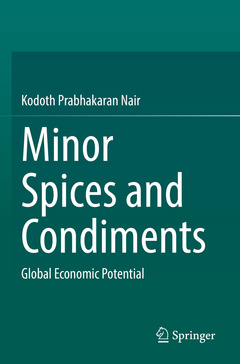Description
Minor Spices and Condiments , 1st ed. 2021
Global Economic Potential
Author: Nair Kodoth Prabhakaran
Language: English
Subjects for Minor Spices and Condiments :
Approximative price 179.34 €
In Print (Delivery period: 15 days).
Add to cartPublication date: 11-2022
226 p. · 15.5x23.5 cm · Paperback
Approximative price 179.34 €
In Print (Delivery period: 15 days).
Add to cartPublication date: 11-2021
226 p. · 15.5x23.5 cm · Hardback
Description
/li>Contents
/li>Biography
/li>Comment
/li>
Spices can be classified as major spices, like Black pepper, Cardamom, Turmeric, Ginger etc, and minor spices and condiments, and tree spices. This book will discuss exclusively minor spices and condiments.
Spices constitute a very important group of agricultural products, which, since antiquity, have been considered indispensable in the culinary art of flavoring foods. The history of spices is very much entwined with the history of mankind. And, some spice crops like Black pepper predominates in the family of spices. In fact, colloquially, it is called ?King?of spices and, another, Cardamom, is called the ?Queen?of spices. There is worthwhile amount of published work, on these in addition to Turmeric and Ginger.
Both ISO (International Organization for Standardization) and ISI (Indian Standards Institution) (now BIS (Bureau of Indian Standards)) experts concluded, after considerable deliberations, that there is no clear-cut division between ?spices? and ?çondiments?, and, as such, they have been clubbed together. The term ?Spices and Condiments? applies to such natural plant or vegetable products or mixtures, thereof, used in whole or ground form, mainly for imparting flavor, aroma and piquancy to foods and also for seasoning of foods and beverages like soups etc.A detailed survey of published literature proves that there are a number of minor spices, which have tremendous commercial potential, globally. And, an authentic book on these will not only serve as an important guide to the academic community, but, also provide a fillip to industry involved in value addition.
Chapter 1: INTRODUCTION
Chapter 2: ONION
Chapter3: GARLIC
Chapter 4: LEEK/STONE LEEK/WELSH ONION
Chapater 5: AJOWAN OR BISHOP’S WEED
Chapter 6: CELERY SEED
Chapter 7: CORIANDER
Chapter 8: CUMIN SEED OR SAFAID JEERA
Chapter 9: FENUGREEK
Chapter 10: MUSTARD
Chpater11; CASSIA AND CUMIN
Chapter 12. CINNAMON OR TRUE CINNAMON
Chapter 13: CLOVE
Chapter 14: MACE OR NUTMEG
Chapter 15: ALLSPICE OR PIMENTA OR PIMENTO
Chapter 16: CURRY LEAF
Chapter 17: TAMARIND
Chapter 18: ASAFOETIDA OR ASAFETIDA
Chapter 19: VANILLAA reference tool to aid in research into minor spices, condiments and tree spices
A policy guidance manual for those engaged in spices trade
Insights into the global spice industry and the economic potential of spices




